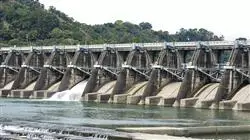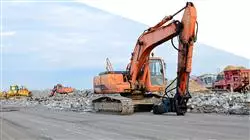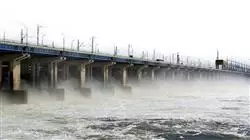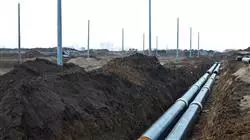University certificate
Scientific endorser

The world's largest faculty of engineering”
Introduction to the Program
TECH offers you a teaching format 100% online and with a team of teachers experienced in Hydraulic Works”

Previously, the construction of hydraulic works generated high costs in their execution and maintenance, in addition to not contributing to the environment by not having the tools that were linked to techniques and materials designed for sustainable construction. That is why today this type of hydraulic infrastructure works are focused on helping to mitigate environmental problems by ensuring access to clean water for communities. In this sense, the professionals will apply the concepts of surface hydrology to natural environments to perform hydrological models of basins and urban hydrological models.
This is a field that day by day is being updated in aspects of materials, methods and techniques that contribute to natural preservation and the development of the execution of works that help to make a better water management. Therefore, this Professional master’s degree from TECH will provide the graduates with in-depth and advanced knowledge in the typology of dams and the main water purification processes. The focus of its content is guided to the design and construction of hydraulic infrastructures that allow the supply of water resources to urban supply and purification systems.
In this way, the professionals will acquire knowledge and specific skills, such as in the approach of solutions to real civil engineering problems using advanced software, deepening in concepts such as methodology and BIM model. A program that integrates a specialized teaching team and at the same time, supported with quality multimedia content that offers dynamism and comfort with the online modality.
TECH provides an excellent opportunity for engineers who wish to combine their work and personal responsibilities with a quality university education. The professionals will only need an electronic device with Internet connection to access the virtual platform at any time. In this way, students will be able to distribute the teaching load according to their needs.
The professionals will apply the concepts of surface hydrology to natural environments to carry out hydrological models of basins and urban hydrological models”
This Professional master’s degree in Hydraulic Works Infrastructure contains the most complete and up-to-date program on the market. The most important features include:
- The development of case studies presented by experts in Civil Engineering focused on Hydraulic Works
- Graphic, schematic, and practical contents with which they are created, provide scientific and practical information on the disciplines that are essential for professional practice
- Practical exercises where self-assessment can be used to improve learning
- Its special emphasis on innovative methodologies
- Theoretical lessons, questions to the expert, debate forums on controversial topics, and individual reflection assignments
- Content that is accessible from any fixed or portable device with an Internet connection
This Professional master’s degree will provide you with advanced knowledge in the typology of dams and the main water purification processes"
The program’s teaching staff includes professionals from sector who contribute their work experience to this educational program, as well as renowned specialists from leading societies and prestigious universities.
Its multimedia content, developed with the latest educational technology, will provide the professionals with situated and contextual learning, i.e., a simulated environment that will provide an immersive education programmed to learn in real situations.
The design of this program focuses on Problem-Based Learning, by means of which the professionals must try to solve the different professional practice situations that are presented throughout the academic course. For this purpose, the students will be assisted by an innovative interactive video system created by renowned experts.
Deepen your skills and become an expert engineer in hydraulic infrastructures"

In TECH you will only need a device with Internet connection and you will be able to access the virtual platform at any time"
Syllabus
This syllabus has been designed according to the recent and innovative construction techniques in Hydraulic Works Infrastructure that have been developed within the sector. In this way, a syllabus has been created whose Modules offer a wide perspective of the designs and construction management involved in the hydraulic infrastructures of catchment and also of urban systems, from a vision of its application at international level, incorporating all the knowledge of the digital technologies involved in the development of the activities of a civil engineer. For this, the professionals will have the help of an innovative interactive video system made by recognized experts in engineering with great experience.

With this academic qualification you will be able to incorporate into your practice multiple knowledge of digital technologies involved in the development of the activities of a civil engineer"
Module 1. Hydrology and Hydraulics for Civil Engineering
1.1. Surface and urban hydrology
1.1.1. Precipitation
1.1.2. Infiltration
1.1.3. Groundwater
1.1.4. Flow rate. Duration and mass curves
1.1.5. Probability distribution functions used in hydrology
1.1.6. Analysis of drought frequencies
1.1.7. Stochastic Processes Time series models
1.2. Rainfall. Precipitation - Runoff Ratio
1.2.1. The design storm
1.2.2. Historical analysis of maximum rainfall intensities
1.2.3. Flood hydrographs
1.3. Hydrological parameters of catchment areas
1.3.1. Typical hydrograph
1.3.2. Unit Hydrograph
1.3.3. Dimensionless Hydrographs
1.3.4. Triangular Hydrographs
1.4. Determination of discharge flow rates
1.4.1. Flood flow
1.4.2. Transit of reservoirs
1.4.3. Transit in natural watercourses
1.5. Hydrological Modeling
1.5.1. Témez method
1.5.2. Rational Method
1.5.3. SCS Method
1.5.4. Hydraulic Modeling
1.6. Hydraulic Modeling
1.6.1. Hydromechanics
1.6.2. Flows and currents
1.6.3. Movements in hydraulic infrastructures
1.7. Free sheet pipelines. Hydraulic fundamentals
1.7.1. Water flow in pipelines
1.7.2. Classification of flows in channels
1.7.3. Flow states
1.8. Properties of flow in open channels
1.8.1. Types of open channels
1.8.2. Geometry of an artificial channel
1.8.3. Elements of a channel section
1.8.4. Velocity and pressure distribution in channels
1.8.5. Flow energy in open channels
1.8.6. Critical flow status
1.8.7. Local phenomena. Hydraulic Highlighting
1.9. Uniform motion in channels
1.9.1. Uniform flow characteristics
1.9.2. Uniform flow equations
1.9.3. Common formulas for uniform motion in channels
1.10. Varied motions
1.10.1. Gradually varied motion in rivers and streams
1.10.2. Wave propagation
1.10.3. Pressures and dynamic forces
1.10.4. Waves and Water hammer
1.10.5. Valve closure. Gradual, rapid and instantaneous
Module 2. Dams, catchments and water treatment. Elements and design
2.1. Water Storage System
2.1.1. Water Storage Systems
2.1.2. Surface and subway storage
2.1.3. Water Pollution Problems
2.2. Surface water catchment
2.2.1. Rainwater catchment
2.2.2. Catchments in river courses
2.2.3. Catchments in lakes and reservoirs
2.3. Groundwater abstraction
2.3.1. Groundwater
2.3.2. Protection of aquifers
2.3.3. Calculation of wells
2.4. Dams
2.4.1. Types of dams
2.4.2. Main elements of dams
2.4.3. Previous studies
2.5. Spillways and drains
2.5.1. Typology
2.5.2. Avenues study
2.5.3. Main Components
2.6. Construction of dams
2.6.1. River diversion
2.6.2. Construction of cofferdams and closure of the river bed
2.6.3. Constructive considerations on dams of different typology
2.7. Water purification
2.7.1. Water Treatment
2.7.2. Treatment Processes
2.7.3. Treatment equipment
2.8. Drinking water treatment processes
2.8.1. Treatment of Other Pollutants
2.8.2. Additives in drinking water treatment
2.8.3. Disinfection
2.9. By-products of water treatment
2.9.1. Nature of Sludge
2.9.2. Treatment Processes
2.9.3. Final destination of sludge
2.10. Dams as a renewable energy generation system
2.10.1. Renewable energy generation
2.10.2. Reservoirs and pumping stations as a source of clean energy generation
2.10.3. International energy regulation
Module 3. Modeling of dams
3.1. Digital construction
3.1.1. Digital construction
3.1.2. Building Information Models
3.1.3. BIM Technology
3.2. Dam modeler. Civil 3D
3.2.1. Civil 3D interface
3.2.2. Workspaces
3.2.3. Template configuration
3.3. Site survey
3.3.1. Preliminary site analysis
3.3.2. Civil 3D model preparation
3.3.3. Study of Alternatives
3.4. Civil 3D modeling strategy
3.4.1. Workflow
3.4.2. Model of linear works in Civil 3D
3.4.3. Modeling strategy for loose material dams
3.4.4. Modeling strategy for gravity dams
3.5. Creation of assemblies for weir bodies
3.5.1. Methods for the creation of subassemblies
3.5.2. Choice of the type profile
3.5.3. Creation of subassemblies from the profile type
3.6. Generation of the gravity dam linear structure
3.6.1. Design slope
3.6.2. Creation of the Linear Work
3.6.3. Parameters and surface of the linear work
3.6.4. Checking the proper functioning of the assemblies
3.7. Complementary works
3.7.1. Dam spillway
3.7.2. Dam crest roads
3.7.3. Interior galleries
3.8. Parameterization in Civil 3D
3.8.1. Types of properties according to their origin
3.8.2. Property types by data format
3.8.3. Creation of user-defined parameters
3.9. Generation of the dam body model in Revit
3.9.1. Model preparation in Revit
3.9.2. Dynamo routine for the creation of solids from Civil 3D to Revit
3.9.3. Execution of the Dynamo routine
3.10. Model of a gravity dam in Revit
3.10.1. Dam body
3.10.2. Construction divisions
3.10. 3 Control and maneuvering installations
Module 4. Channels and river channelization. Elements and design
4.1. Properties of flow in open channels. Hydraulic fundamentals
4.1.1. Classification of flows in channels
4.1.2. Types of open channels
4.1.3. Geometry of an artificial channel
4.1.4. Elements of a channel section
4.1.5. Velocity and pressure distribution in channels
4.1.6. Flow energy in open channels
4.1.7. Critical flow status
4.1.8. Local phenomena. Hydraulic Highlighting
4.2. Formulation of channel flows
4.2.1. Uniform motion in channels
4.2.2. Gradually varying flow in channels
4.2.3. Characteristics of gradually varied motion in channels
4.2.4. General formula for draft variation
4.2.5. Cases of gradually varied motion
4.3. Geometric definition of the standard section
4.3.1. Initial Aspects
4.3.2. Design Criteria
4.3.3. Channel lining
4.3.4. Guards in canals
4.3.5. Types of drainage
4.4. Concrete-lined channels
4.4.1. Concrete-lined channels
4.4.2. Construction Aspects
4.4.3. Types of joints in Concrete Channels
4.4.4. Construction phases of a canal
4.5. Canal layout
4.5.1. The layout of a canal
4.5.2. Aqueducts
4.5.3. Tunnels
4.5.4. Siphons
4.5.5. Channeling of rivers
4.6. Special elements in canals
4.6.1. Transitions between different sections
4.6.2. Desanders
4.6.3. Gauging
4.7. Regulation in canals
4.7.1. Manual gates
4.7.2. Hydraulically operated by-pass dampers
4.7.3. Hydraulically operated automatic control dampers
4.7.4. Duckbill weirs
4.8. Spillways
4.8.1. Design
4.8.2. Fixed lip spillways
4.8.3. Siphon spillways
4.9. HEC-RAS for simulation in free sheeting
4.9.1. HEC-RAS. Features
4.9.2. Limitations in channel modeling
4.9.3. Data required for modeling
4.9.4. Results Obtained
4.10. Modeling Strategy
4.10.1. Civil 3D design of the civil works in plan
4.10.2. Longitudinal Profiles in Civil 3D
4.10.3. Cross Sections in Civil 3D
Module 5. Reservoirs, elements and design
5.1. Tanks
5.1.1. Deposit
5.1.2. Functionality of a Header Reservoir
5.1.3. Other Uses
5.2. Classification of Deposit
5.2.1. According to their Arrangement on the Terrain
5.2.2. According to its Constructive Process
5.2.3. According to its Material
5.2.4. According to their Relative Position in the Network
5.3. Reservoir Design
5.3.1. Types of Demand and Utilization
5.3.2. Design Requirements
5.3.3. Topography
5.3.4. Financial Elements
5.3.5. Others
5.4. Sizing of a Reservoir
5.4.1. Reservoir Dimensions
5.4.2. Height of the Sheet of Water
5.4.3. Capacity
5.5. Components of the Reservoirs
5.5.1. Enclosure Walls
5.5.2. Dividing Walls
5.5.3. Sills
5.5.4. Guide Partitions
5.5.5. Roof
5.5.6. Joints
5.5.7. Key Chamber
5.6. Equipment of the Reservoirs
5.6.1. Schematic Diagram of Basic Installations
5.6.2. Valves
5.6.3. Drainage
5.6.4. Control Elements
5.7. Maintenance and Conservation of Reservoirs
5.7.1. Applicable Regulations
5.7.2. Tank Cleaning
5.7.3. Maintenance of Reservoirs
5.8. Revit Reservoir Modeling Strategy
5.8.1. Revit Modeler Environment
5.8.2. Levels and Reference Planes
5.8.3. Revit Families
5.9. Operational Information. Set of reservoir parameters
5.9.1. Property Sets
5.9.2. Application of PSET to BIM objects
5.9.3. Export of Properties. Attributes to Databases
5.10. Management with Visualization Tools
5.10.1. Software to Visualize the Models
5.10.2. Information Requirements
5.10.3. BIMDATA IO Viewer
Module 6. Irrigation. Elements and design
6.1. Irrigation networks
6.1.1. Irrigation network
6.1.2. Physical characteristics of the soil
6.1.3. Factors influencing irrigation
6.1.4. Soil water storage
6.1.5. Irrigation dosage
6.1.6. Crop water requirements
6.2. Types of irrigation
6.2.1. Gravity irrigation
6.2.2. Sprinkler irrigation
6.2.3. Drip irrigation
6.3. Pressure networks Hydraulic fundamentals
6.3.1. Flow energy
6.3.2. Bernoulli's Equation
6.3.3. Energy losses in pipelines
6.4. Sprinkler irrigation networks Features
6.4.1. Sprinklers
6.4.2. System Types
6.4.3. Hydraulic characteristics of sprinklers
6.4.4. Distribution of sprinklers in conventional systems
6.4.5. Uniformity and efficiency
6.5. Sizing of sprinkler irrigation networks
6.5.1. Design Criteria
6.5.2. Side branches
6.5.3. Distribution Networks
6.6. Drip irrigation networks
6.6.1. System Components
6.6.2. Uniformity and efficiency
6.6.3. Installation diagram
6.6.4. Micro-sprinkler
6.7. Dimensioning of drip irrigation systems
6.7.1. Design Criteria
6.7.2. Side branches
6.7.3. Bypass piping
6.7.4. Distribution piping
6.8. Modeling of irrigation networks in Civil 3D
6.8.1. Elements catalog
6.8.2. Network modeling
6.8.3. Irrigation network profile
6.9. Modeling of retention basins in Civil 3D
6.9.1. Flattening element
6.9.2. Footprint design
6.9.3. Volume measurements
6.10. Deliverables of an irrigation network
6.10.1. Plan alignment drawings
6.10.2. Plan and profile drawings
6.10.3. Transversal Sections and Measurements
Module 7. Upstream supply systems. Water transport pipelines
7.1. Types of Upstream supply systems
7.1.1. Gravity conveyance systems
7.1.2. Pressure transport systems
7.1.3. Components
7.2. Design of upstream supply systems
7.2.1. Plan Layout
7.2.2. The pipeline profile
7.2.3. Buried pipelines
7.2.4. Headworks, midstream and tailrace reservoirs
7.2.5. Components
7.3. System Dimensioning
7.3.1. Magnitude and time distribution of demand
7.3.2. Design Flow Rate
7.3.3. Design Criteria
7.3.4. Mechanical calculation of pipelines
7.4. Head losses in pipelines
7.4.1. Linear losses
7.4.2. Localized losses
7.4.3. Economic diameter
7.5. Tunnel pipelines
7.5.1. State of rock mass loadings
7.5.2. Excavation distortion
7.5.3. Bearing
7.5.4. Free sheet tunnels
7.5.5. Pressurized galleries
7.6. Singular elements
7.6.1. Lift stations
7.6.2. Hydraulic study of the elevator
7.6.3. Siphons operation
7.6.4. Siphon calculation and design
7.7. Structural protection of the pipeline
7.7.1. Water Hammer
7.7.2. Calculation of water hammer in pipelines
7.7.3. Elements of protection against the water hammer
7.8. Other protections
7.8.1. Cathodic protections
7.8.2. Coatings
7.8.3. Types of Coatings for pipelines
7.8.4. Valves and suction cups
7.9. Materials in high pressure supply systems
7.9.1. Regulations and selection criteria
7.9.2. Ductile iron pipes
7.9.3. Helical welded steel pipes
7.9.4. Reinforced and prestressed concrete pipelines
7.9.5. Pipes made of plastic materials
7.9.6. Other Materials
7.9.7. Quality control of materials
7.10. Connecting, operating and control elements
7.10.1. Types of joints and elements
7.10.2. Valves
7.10.3. Aeration valves or suction cups
7.10.4. Complementary elements
Module 8. Urban drainage and design
8.1. Sanitation Networks
8.1.1. Sanitation Network
8.1.2. Typologies of sewerage networks
8.1.3. Network layout
8.2. Network Elements
8.2.1. Pipelines
8.2.2. Manholes
8.2.3. Connections
8.2.4. Surface catchment elements
8.2.5. Spillways
8.3. Materials in sewerage networks
8.3.1. Selection Criteria
8.3.2. Concrete pipes
8.3.3. Pipes
8.3.4. Fiberglass reinforced polyester pipes
8.4. Geotechnics in the hydraulic works of sanitation
8.4.1. Phases of a reconnaissance campaign
8.4.2. Most common tests
8.4.3. Calculation and stability parameters in trenches for sewerage collectors
8.5. Sizing criteria
8.5.1. Design Criteria
8.5.2. Main factors in the design
8.5.3. Design parameters and variables
8.6. Dimensioning of sewerage networks
8.6.1. Urban hydrology
8.6.2. Fundamental Equations
8.6.3. Performance criteria
8.7. Simulation of sewage networks in SWWM
8.7.1. Network Elements
8.7.2. Contribution basin
8.7.3. Design rainfall
8.7.4. Hydraulic profile of conduits
8.7.5. Results
8.8. Retention tanks
8.8.1. Planning and location
8.8.2. Cleaning systems
8.8.3. Auxiliary Elements
8.9. Modeling of sewage networks in Civil 3D
8.9.1. Workflow in Civil 3D
8.9.2. Networks Creation Tools
8.9.3. Network creation
8.10. Network Analysis with Storm and Sanitary Analysis (SSA)
8.10.1. Network export from Civil 3D to SSA
8.10.2. Hydraulic-hydrologic modeling of the network
8.10.3. Hydraulic calculations
8.10.4. Results Obtained
Module 9. Sustainable Urban Drainage System Design
9.1. Sustainable Urban Drainage System Design
9.1.1. Floor Sealing
9.1.2. Climate Change
9.1.3. Sustainable Drainage System
9.2. Sustainable Urban Drainage System Types(SUDS)
9.2.1. Transport
9.2.2. Filtration and Infiltration
9.2.3. Retention and Reuse
9.3. Intervention Conditions and Levels
9.3.1. Factors Intrinsic to the Receiving Environment
9.3.2. Physical Factors
9.3.3. Factors Related to Land Use
9.3.4. Socio-environmental Factors
9.3.5. Capacity to Manage Urban Runoff Waters
9.3.6. Sustainable Urban Drainage System Choice(SUDS)
9.4. Pillars in the design of SUDS
9.4.1. Water Quantity
9.4.2. Water Quality
9.4.3. Others
9.4.4. Typologies in Relation to their Main Functions
9.5. Sustainable Urban Drainage Systems (SUDS) of detention and retention
9.5.1. Detention and Infiltration basins
9.5.2. Vegetable Covers
9.5.3. Cisterns or Rainwater Reservoirs
9.6. Sustainable Urban Drainage Systems (SUDS) of Filtration
9.6.1. Filter Strips
9.6.2. Drainage Ditches
9.6.3. Sand Filters
9.6.4. Permeable Pavements
9.7. Sustainable Urban Drainage Systems (SUDS) of Infiltration
9.7.1. Structural Cork Oaks
9.7.2. Gardens Rain meadows
9.7.3. Wells and Infiltration Ditches
9.7.4. Reticulated Reservoirs
9.8. Sustainable Urban Drainage Systems (SUDS) of Treatment
9.8.1. Floodable Flowerbeds
9.8.2. Vegetated Swales
9.8.3. Artificial Wetlands and Ponds
9.9. Civil 3D Model of Parametric Infiltration Sections
9.9.1. Catalog of Parametric Sections
9.9.2. Bioretention
9.9.3. Rain Garden
9.9.4. Permeable Sidewalk
9.9.5. Permeable Pavements
9.9.6. Others
9.10. Sustainable Urban Drainage System Modeling(SUDS) in Civil 3D
9.10.1. BIM modeling of SUDS in Civil 3D
9.10.2. Assembly Creation
9.10.3. Creation of the Linear Work
Module 10. Debugging. Elements and design
10.1. Wastewater
10.1.1. Domestic Water
10.1.2. Industrial Water
10.1.3. Specific Pollutants
10.2. Purification Processes
10.2.1. Physical Processes
10.2.2. Physicochemical Processes
10.2.3. Biological Processes
10.3. Selection Criteria According to the Quality of the Discharge
10.3.1. Water Uses
10.3.2. Performance of the Purification Processes
10.3.3. Implementation Considerations
10.4. Pre-treatment
10.4.1. Components
10.4.2. Design Parameters
10.4.3. Performance
10.5. Primary Treatment
10.5.1. Components
10.5.2. Design Parameters
10.5.3. Performance
10.6. Secondary Treatment
10.6.1. Biological Purification
10.6.2. Components
10.6.3. Design Parameters
10.6.4. Performance
10.7. Tertiary Treatment
10.7.1. Components
10.7.2. Design Parameters
10.7.3. Performance
10.8. Sludge: Production, Treatment and Uses
10.8.1. Sludge Production and Treatment Systems
10.8.2. Design Parameters
10.8.3. Performance
10.9. Auxiliary Systems and Current Trends
10.9.1. Instrumentation and Control in a WWTP
10.9.2. Deodorization
10.9.3. Cogeneration
10.10. Modeling of a WWTP
10.10.1. BIM modeling of a WWTP
10.10.2. Uses of Biogas from Biological Processes in WWTPs
10.10.3. Uses of Sludge

The professional will be assisted by an innovative interactive video system developed by renowned engineering experts”
Professional Master's Degree in Hydraulic Works Infrastructure
In a global context of climate change and population growth, sustainability is fundamental. Therefore, access to clean and safe water is essential for life and sustainable development. Would you like to specialize in the design and management of hydraulic projects? You've come to the right place. At TECH Global University we are pleased to introduce you to the Professional Master's Degree in Hydraulic Works Infrastructure, a 100% online postgraduate program that will provide you with the technical skills and advanced knowledge to meet the challenges of water in an ever-changing world, where sustainability and efficiency are fundamental. Our curriculum focuses on preparing you to be able to address the planning, design and construction of water infrastructure, including drinking water supply systems, sanitation networks, irrigation systems and flood control. In addition, you will learn to integrate concepts of water efficiency, resource conservation and eco-friendly technologies, ensuring that your water projects are environmentally friendly and socially responsible.
Learn all about water infrastructure
Technological advancement has revolutionized hydraulic engineering, therefore, our program will train you in the use of cutting-edge tools and software, hydraulic simulations, data modeling and geographic information systems (GIS), which will allow you to make informed and accurate decisions in project design. Our faculty is comprised of professionals with extensive experience in the field of hydraulic engineering. Their practical knowledge of real projects will provide you with solid training tailored to the needs of the modern working world. In addition to technical skills, we will provide you with knowledge in project management, leadership and strategic decision making. These competencies will prepare you to assume leadership roles in the management and execution of large-scale water projects. In short, the Professional Master's Degree in Hydraulic Works Infrastructure will open doors in the national and international job market. You will be able to work in government agencies, engineering companies, consulting firms and organizations dedicated to water management and sustainable development.







